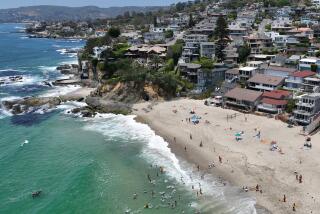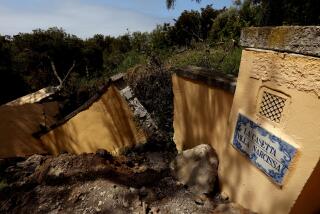Solana Beach Keeps Trying to Prop Up Its Eroding Bluffs
Standing near the top of the 123 stairs that lead down to Solana Beach, you look to the left and see a huge tiered cement structure that climbs from close to the beach all the way to the condominiums atop the bluff.
Look to the right from the stairs near the end of Del Mar Shores Terrace, and you see two more huge structures. Both are peach-colored, maybe 30 feet high. They, too, run nearly the entire depth of the bluff.
The sea walls, like others on Solana Beach and all along the coast, are designed to keep the condominiums above from falling down to the beach, as erosion--produced by nature and exacerbated by man--eats away at the bluffs.
In Solana Beach, where sandstone bluffs and extensive development make the problem worse than it is elsewhere, homeowners are increasingly building sea walls and plugging sea caves with cement to stem the erosion of the bluffs.
There are only about half a dozen sea walls in the community, which voted to become a city just a year ago. But several walls are on the drawing board. In the next few years, as homeowners become aware of the long-term dangers of living on the edge of a bluff, proposals for sea walls and similar devices are expected to proliferate.
Just Plain Ugly
That distresses Solana Beachâs planning director, Steve Apple, who, like many others, thinks that sea walls and sea cave plugs are just plain ugly.
âThe engineering solution to the eroding cliffs (in the short term) is really easy--you cement the entire cliff,â said Apple, who has been Solana Beachâs planning director since the city was incorporated July 1, 1986.
But, he added, âIf weâre not careful, weâre going to end up with sea walls all along the coast of Solana Beach.â
In the long run, said Apple, people who build sea walls are fighting a losing battle. Inevitably, the waves will wear down the bluffs and start tearing at the condominiums on top. It may take decades or centuries, but it will happen.
âAt best, what we can do is take temporary, stop-gap measures that will last the lifetime of the structures or the lifetime of the individuals here,â he said.
In Solana Beach, erosion is an especially serious threat because the town has been nearly filled with development. The town is 94% âbuilt out,â Apple said.
Along the bluffs overlooking the Pacific Ocean, the development is also highly concentrated. Beginning in the early â70s, large condominium developments were built all along the coast. There are now 850 units along the blufft tops of Solana Beach, Apple said.
That wouldnât be a problem if the developments had been set back far enough from the edge of the cliff.
As things are, however, most of the setbacks are âwoefully inadequate,â Apple said. Some are as close as two feet from the edge.
Threat Not Understood
One reason the condominiums were built so close to the edge is that experts have only recently come to believe that erosion poses a serious threat to the buildings. Basing their understanding on old photographs that showed virtually no changes due to erosion, developers routinely built homes just a few feet from the edge of the bluffs, and had no problem getting government approval.
Newer photographs, however, âhave been taken frequently enough to comprise a series that shows an amazing amount of change in an area previously thought by land developers to be stable,â geologist Gerry Kuhn wrote in a 1984 book examining the coastline of San Diego County.
Kuhn, who works for the Scripps Institution of Oceanography, said that when studies of the area were done between the end of World War II and the mid-â70s, geologists found little change in the face of the bluffs, âmainly because the period between 1947 and â77 was a time of very few storms, very little erosion along the coast . . . and that became entrenched in the engineering and geology beliefs of the time.â
Beginning in the late â70s, however, erosion of the bluffs became a serious long-term problem as winter storms became more severe. Because erosion is episodic, some areas of coastline can lose several feet of land in one long storm.
For homeowners living on the edge, that discovery came too late. Now they are paying the price by having to protect their homes with costly devices that donât always work, Apple said.
$50,000 to Plug a Cave
The Las Brisas Homeowners Assn. in Solana Beach will pay about $50,000 to plug a sea cave just below the development this fall. The cave is dangerous because if it collapses, it could open up that area of the bluff to catastrophic erosion. A collapse could also injure people sitting in the cave.
Beachgoers carve their initials in the cave, which goes about 20 feet into the bluff, and illegal aliens and transients sometimes sleep in it at night.
âTo me, common sense dictates donât play in a sea cave,â Apple said. âIâm not paranoid but I wouldnât even take a nap in one.â
Jim Zeller, treasurer of the Las Brisas Homeowners Assn., said signs have been posted warning people to stay out of the cave, but âtheyâre taken down very quickly. They donât do any good.â
Although the cave is accessible from a public beach, it is part of the Las Brisas property. The development, after receiving the go-ahead to plug the cave from the state Coastal Commission, got final permission from the city in June. But the city told the owners they had to wait until after Labor Day so the construction wouldnât interfere with the beach crowd.
In June, the Solana Beach City Council approved the plugging of five sea caves below a home on Pacific Avenue. Mayor Margaret Schlesinger expressed reservations about the plan, in part because as the bluffs erode, the plugs may be left sticking out onto the beach.
âI have reservations about anything that you do to the bluffs. I think weâre just asking for trouble when you do anything to change the natural scheme of things,â she said. âUnfortunately, I understand the reality of the situation is that inappropriate development was allowed all along the bluff.â
Blames County Supervisors
The county Board of Supervisors, which had authority over the area before Solana Beach was incorporated, acted extremely irresponsibly when it approved developments on the edge of the bluffs, Schlesinger said. Objections to the developments âfell on totally deaf ears,â she said.
Despite her reservations, Schlesinger cast her vote in favor of plugging the caves. The City Council has also approved the construction of a sea wall below homes on Circle Drive, where one of the homes is actually partly hanging off the edge.
Louis Lee of Woodward-Clyde Consultants, which designs sea walls and sea cave plugs, said most plugs are designed to blend in with the surrounding environment. âTo make it look reasonably nice, you try to construct something that will follow the contour and color of the bluff,â he said.
In addition, Lee said, many sea cave plugs are built with a joint about two feet from the end of the plug, so the cement can be broken off if erosion eats away at the surrounding bluff.
Despite the potential long-term danger, the condominiums along the bluffs are hot properties, most of them in the $200,000 to $300,000 range. Helen Lyon, whose husband manages the Del Mar Terrace development in Solana Beach, said she is ânot one bitâ worried about the erosion.
âWe have four (residents) that just bought another unit, so you can see how worried they are about it,â she said.
Because it is too late to do much about the homes too close to the edge of the bluffs, Apple has a number of recommendations to minimize erosion there: people should refrain from carving initials in sea caves or on the bluffs; homeowners along the cliffs should minimize how much they water their backyards, and homeowners should not toss debris over the edge.
Finally, Apple said, âpray for mild winters,â because in the long run, erosion will win.
âSomeday Highway 101 will be beachfront property--probably not in our lifetimes, but it will happen.â
More to Read
Sign up for The Wild
Weâll help you find the best places to hike, bike and run, as well as the perfect silent spots for meditation and yoga.
You may occasionally receive promotional content from the Los Angeles Times.






